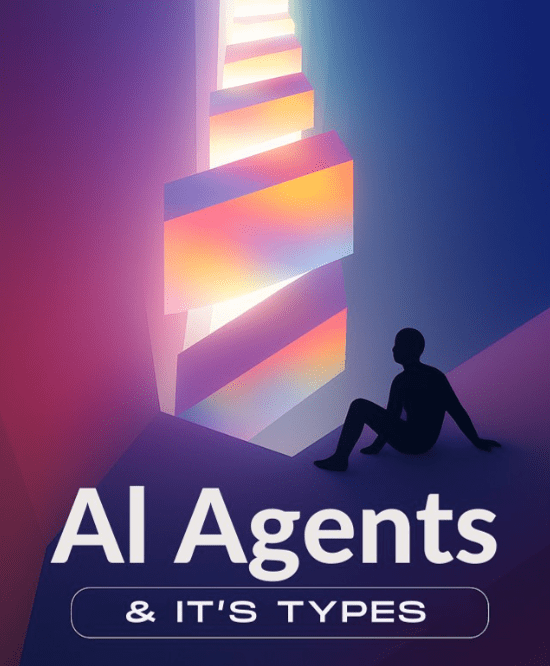Artificial Intelligence (AI) is reshaping industries, from healthcare to logistics, through autonomous systems known as AI agents. Unlike traditional automation, AI agents perceive their environments, make decisions, and take actions to achieve goals, often adapting to new situations through learning. A recent LinkedIn post outlined five distinct types of AI agents—simple reflex, model-based, goal-based, utility-based, and learning agents—each with unique capabilities and architectures. In this blog, we dive deep into these five types, exploring how they work, their real-world applications, and why they’re critical to the future of AI. Whether you’re a developer, business leader, or AI enthusiast, this guide will help you understand the power and potential of AI agents in 2025.
What Are AI Agents?
AI agents are intelligent systems designed to act independently to complete tasks or achieve objectives. Unlike basic automation, which follows rigid scripts, AI agents:
- Perceive: Use sensors (e.g., cameras, data inputs) to gather environmental data.
- Process: Analyze information to make informed decisions.
- Act: Execute actions via actuators (e.g., robotic arms, software outputs) to influence their environment.
- Adapt: Learn from experiences to improve performance over time.
The LinkedIn post identifies five types of AI agents, each with distinct decision-making mechanisms and use cases. Let’s explore them in detail.
The 5 Types of AI Agents
1. Simple Reflex Agents
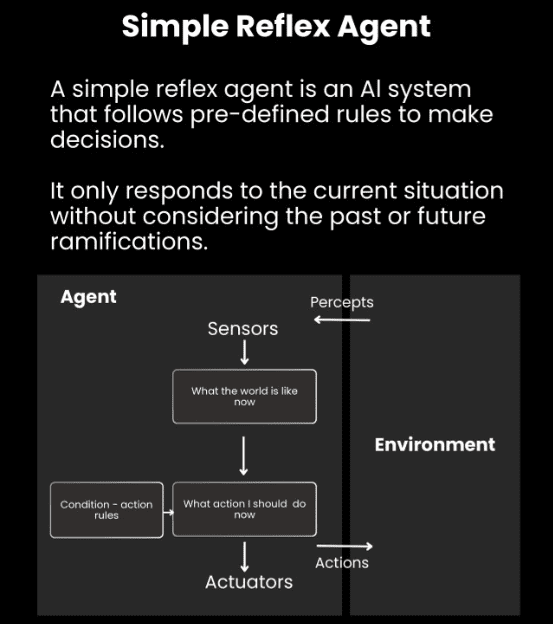
How They Work: Simple reflex agents operate using pre-defined condition-action rules, responding only to the current situation (or “percept”) without considering past or future consequences. They excel in fully observable environments where all relevant information is available.
Architecture:
- Relies on “if-then” rules (e.g., “If obstacle detected, stop”).
- Ignores historical data or future predictions.
- Limited to immediate stimuli.
Applications: - Thermostats adjusting temperature based on current readings.
- Basic chatbots responding to specific keywords (e.g., “Hi” triggers “Hello!”).
Limitations: Fails in partially observable or dynamic environments due to its lack of memory or foresight.
Example: A robotic vacuum that turns left when it hits a wall.
2. Model-Based Reflex Agents
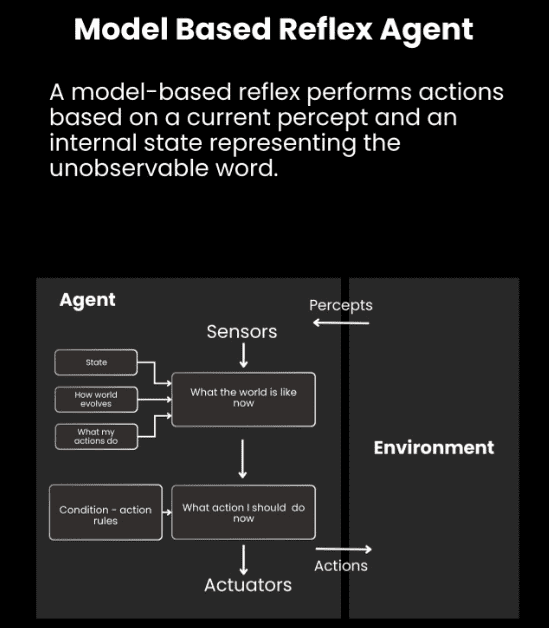
How They Work: These agents maintain an internal state to track aspects of the world that aren’t directly observable, allowing them to handle partially observable environments. They combine current percepts with this internal model to decide actions.
Architecture:
- Stores an internal state reflecting the world’s evolution (e.g., past sensor data).
- Considers how actions affect the environment.
- Updates the internal model based on new percepts.
Applications: - Self-driving cars tracking road conditions and traffic signals.
- Smart home systems adjusting lighting based on time and occupancy patterns.
Limitations: Requires accurate modeling of the environment, which can be complex.
Example: A navigation app rerouting based on real-time traffic data and historical patterns.
3. Goal-Based Agents
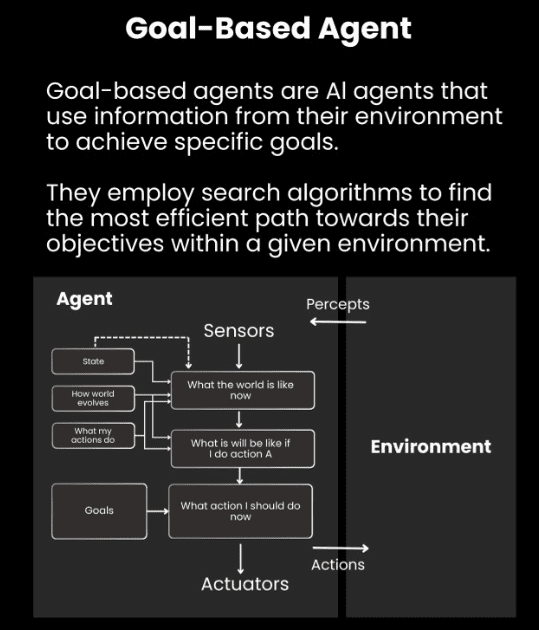
How They Work: Goal-based agents focus on achieving specific objectives, using search algorithms and planning to evaluate multiple action sequences and select the most efficient path to their goal.
Architecture:
- Incorporates goal information to guide decision-making.
- Uses search techniques (e.g., A* algorithm) to explore possible outcomes.
- Plans actions to minimize costs or maximize success.
Applications: - Delivery drones optimizing routes to reach destinations.
- AI in gaming navigating characters to complete missions.
Limitations: Computationally intensive for complex goals or large environments.
Example: A warehouse robot planning the shortest path to retrieve an item.
4. Utility-Based Agents
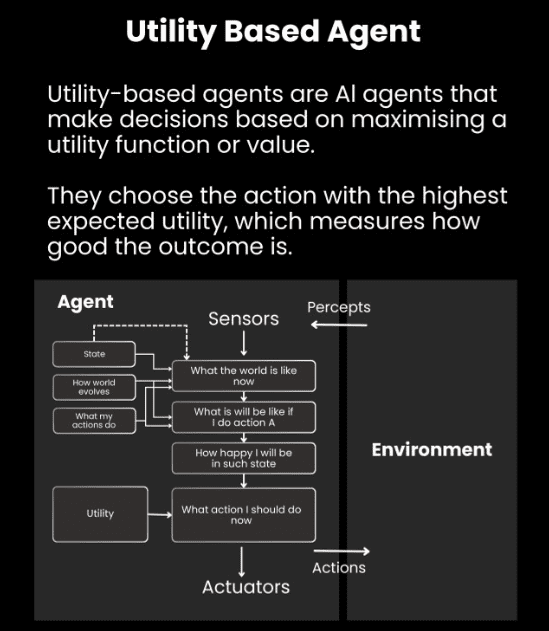
How They Work: These agents go beyond achieving goals by maximizing a utility function—a measure of “desirability” or “happiness” for different outcomes. They choose actions with the highest expected utility, handling trade-offs and uncertainty.
Architecture:
- Assigns utility values to possible states or outcomes.
- Evaluates actions based on expected utility under uncertainty.
- Balances multiple objectives (e.g., speed vs. safety).
Applications: - Recommendation systems (e.g., Netflix suggesting movies based on user preferences).
- Financial trading algorithms optimizing for profit and risk.
Limitations: Requires a well-defined utility function, which can be subjective.
Example: An AI medical system prioritizing treatments based on patient outcomes and costs.
5. Learning Agents
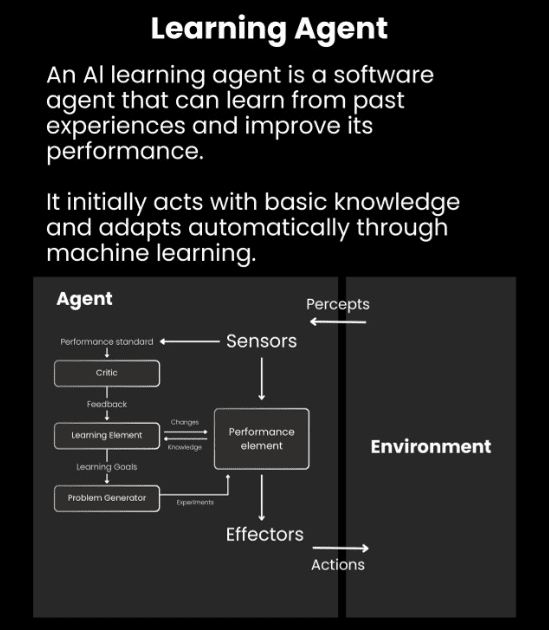
How They Work: Learning agents adapt and improve over time by leveraging past experiences, starting with basic knowledge and evolving through machine learning. They use feedback to refine their decision-making.
Architecture:
- Includes a learning element to update knowledge based on experience.
- Uses a “critic” to evaluate performance against standards.
- Generates experiments to explore new strategies.
Applications: - Personal assistants (e.g., Siri) improving speech recognition with user interactions.
- Autonomous robots learning to navigate unfamiliar environments.
Limitations: Requires significant data and time to learn effectively.
Example: A fraud detection system adapting to new patterns of suspicious activity.
Architectural Differences at a Glance
The LinkedIn post provides a clear breakdown of how these agents differ architecturally:
- Simple Reflex: Condition-action rules; reacts to immediate stimuli; no memory.
- Model-Based: Maintains an internal state; handles partial observability; tracks world evolution.
- Goal-Based: Plans actions to achieve objectives; uses search and planning; goal-driven.
- Utility-Based: Maximizes a utility function; optimizes for desirability; handles uncertainty.
- Learning: Adapts via machine learning; uses critics and experiments; evolves with experience.
These differences determine their suitability for specific tasks, from basic automation to complex decision-making in dynamic environments.
Why AI Agents Types Matter in 2025
AI agents are driving innovation across industries by enabling systems to act autonomously and adapt to real-world challenges. According to a 2024 Gartner report, 80% of enterprises will integrate AI agents into their workflows by 2027, with applications in:
- Healthcare: Utility-based agents prioritizing patient care schedules.
- Logistics: Goal-based agents optimizing supply chain routes.
- Customer Service: Learning agents powering personalized chatbots.
- Finance: Model-based agents detecting fraud in real-time.
As AI agents become more sophisticated, their ability to combine perception, decision-making, and learning will unlock new possibilities, from smart cities to personalized education.
Choosing the Right AI Agent for Your Needs
Selecting an AI agent depends on your use case:
- Simple Tasks in Stable Environments: Use simple reflex agents for cost-effective, straightforward automation (e.g., IoT devices).
- Partially Observable Settings: Opt for model-based agents to handle incomplete data (e.g., autonomous vehicles).
- Specific Objectives: Choose goal-based agents for planning and optimization (e.g., robotics).
- Complex Trade-Offs: Deploy utility-based agents for nuanced decision-making (e.g., financial systems).
- Dynamic, Evolving Needs: Leverage learning agents for adaptability and long-term growth (e.g., Agent Assist).
Conclusion
AI agents are more than advanced automation—they’re autonomous systems that perceive, decide, act, and learn, transforming how we work and live. From simple reflex agents handling basic tasks to learning agents evolving through experience, the five types—simple reflex, model-based, goal-based, utility-based, and learning—offer unique strengths for diverse applications. As we move into 2025, understanding these agents is crucial for developers, businesses, and innovators looking to harness AI’s full potential. By choosing the right agent for the right task, you can drive efficiency, innovation, and impact in an AI-driven world.
Explore Textify’s AI membership
Need Data? Explore the world’s largest Charts database
Explore insights with Textify Analytics
